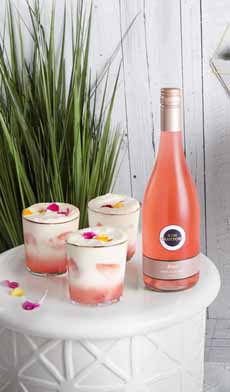TIP OF THE DAY: Frosé, Frozen Rosé Wine Granita For Cocktails Or Dessert

|
Call it a cocktail or call it dessert: We have long enjoyed a frozen rosé cocktail by scooping some sherbet in a glass and topping it off with sparkling wine or still or sparkling rosé.
A couple of years ago, some rosé marketer came up with a new term: frosé! Some winemakers even named bottles of sweet-style rose, frosé. Here are two frosé recipes courtesy of Kim Crawford Wines from New Zealand. He sent these for National Rosé Day, June 10th. (Mr. Crawford must have a sweet tooth: A few years ago, he proposed rosé ice pops. Just add the wine to ice pop molds, with optional berries.) For a cocktail, use a drier-style rosé. For dessert, top sorbet or ice cream with a sweeter rosé: a zinfandel rosé from California, or anything labeled frosé (a relatively new term taking advantage of the trend). Or ask the clerk for guidance. This recipe is a rosé granita, a word that means granular in Italian (granité/granitée is the French word, meaning granite-like). Granita is a rustic version of sorbet, made without an ice cream machine. The ingredients are frozen in a pan. As the crystals on the top freeze, they are scraped into a grainy, coarse cousin of sorbet. Granita, made from sugar, water and flavorings, originated in Sicily. The preferred texture and flavor varies from town to town, where residents variously preferred (and still do) almond, black mulberry, chocolate, coffee, jasmine, lemon, mandarin orange, mint, pistachio and strawberry flavors. But the concept of water ices goes back to China in the fourth century B.C.E. The recipe, as it were, arrived in Persia via traders. Persians enjoyed what we might now call snow cones: snow flavored with syrups. Called sharbat (the origin of sherbet and sorbetto), it was made at least from the middle of the third century B.C.E. Alexander The Great brought the concept back to Greece after he conquered Persia in 330 B.C.E. Gelato, the first type of ice cream, took a while. It is believed to date to Florence, Italy in the late 16th century. Here’s the history of ice cream. And now, back to the frosé, in photo #1. |
|
|
Ingredients For 5 Servings 1. POUR the wine into ice cube trays, a baking pan, or what-have-you and pop it into the freezer. As ice crystals begin to form, scrape them to the front of the pan until frozen solid. You can do this in advance. To serve… 2. USE a hand blender or food processor to process the frozen wine until smooth. Serve directly or freeze again for up to 1 week, covered. Garnish and serve with a spoon and/or straw. Note: We weren’t at home so couldn’t occasionally stir and scrape. So we simply froze the rosé as ice cubes. We then placed the frozen cubes into the blender. The result was a crunchy granita. If we had continued to blend, we might have ended up with something finer, but we liked the crunchiness! Ingredients For 5 Servings ________________ *Use less sugar or omit it entirely if the strawberries are very ripe. 1. COMBINE the strawberries and sugar in a bowl, cover and let sit for 30 to 90 minutes, stirring occasionally. 2. DIVIDE the strawberries and any juices among 5 rocks glasses. Add the wine and a splash of club soda. Top with a scoop of ice cream and garnish (photo #2). |
||



